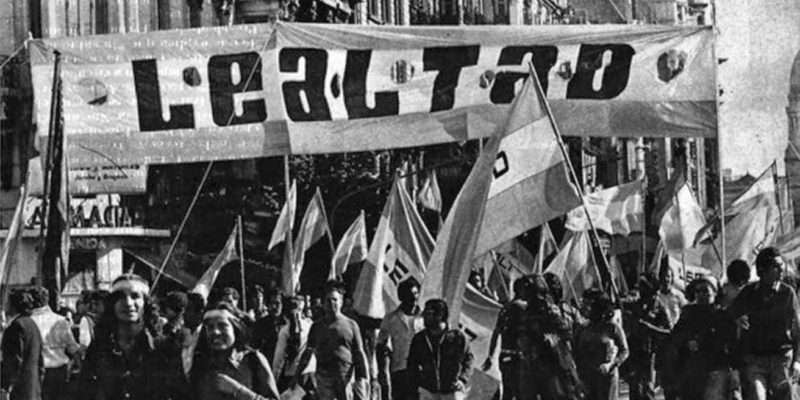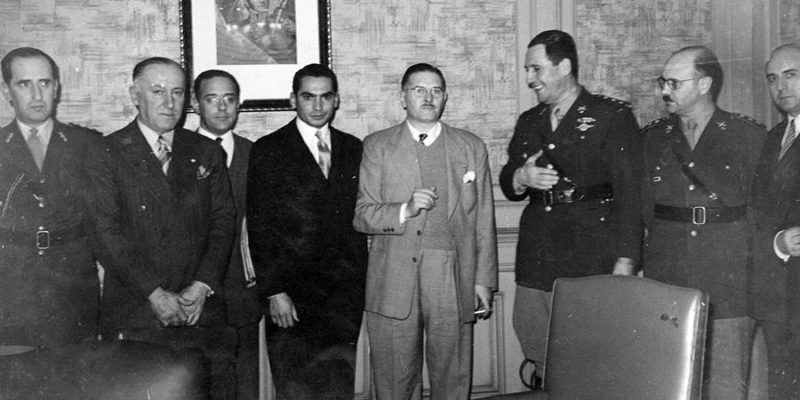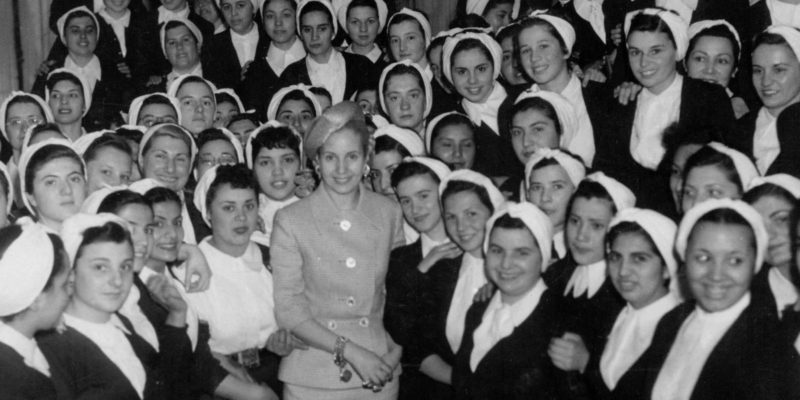We explain what Peronism is, its origin and the mandates it had. In addition, its main characteristics and its three fundamental pillars.
What is Peronism?
Peronism is a populist political regime that emerged in the mid-1940s in Argentina . It was implemented by Lieutenant General (later President) Juan Domingo Perón and his wife Eva Duarte de Perón . Since then, the Peronist ideology has had an important role until today.
Peronism is a doctrine that, despite being created by a military lieutenant like Perón, is considered a leftist ideology that emphasizes the importance of social justice . Hence, it is also called justicialism.
Perón was a colonel in the Argentine army and won the democratic presidential elections on three occasions: 1946, 1952 and 1973. His ideology gained prominence despite the context of economic crisis and coups at the hands of soldiers who did not share his ideas. , such as the integration of rural workers, social justice and economic independence.
Origin of Peronism

During the 1920s, Argentina was one of the main powers in Latin America and one of the most prosperous economies in the world. However, it showed evidence of certain deficiencies for the distribution of that wealth among the entire population .
In 1929 there was a financial crisis in the United States due to the fall of the stock market, which had an immediate and worldwide impact. It was called the Great Depression and it was the longest economic crisis and the one that affected the most number of countries.
Argentina depended, in large part, on foreign trade . After the Great Depression, the government of Hipólito Yrigoyen (the first democratically elected president) suffered the consequences: increased unemployment, reduced wages and social tension, added to a general crisis of the democratic system that invaded all of Latin America.
In 1930, the first military coup took place in Argentina, who overthrew Irigoyen and was replaced by José Félix Uriburu. The authoritarian military government turned out to be corrupt and sought to perpetuate itself in power through electoral fraud.
Perón was part of a group of young soldiers who were sent to Italy to train in the techniques used by the dictator Benito Mussolini. Perón learned, among other things, the importance of accessing the mass media to mobilize the masses and spread his ideology.
From 1930 to 1943, a period characterized by corruption, electoral fraud, and clashes between political parties developed in Argentina , called the Infamous Decade by the journalist of the time, José Luis Torres . It ended in 1943 with the outbreak of the second coup d'état in which a group of young military officers burst into power, including Lieutenant General Juan Domingo Perón.
Peronism emerged gradually, beginning in 1943. Initially, Perón held administrative positions in the state, where he established close relations with the unions. That link would be, time later, a bridge to access high government positions.
In 1945 the military leadership in command noticed that Perón was acquiring more and more prominence in certain popular sectors, such as the support of the unions, for which they asked him to withdraw from the government. Perón accepted, but asked to say goodbye to the population through the national radio network. In his farewell message, he thanked the working class for its support and questioned the continuity of the social benefits that he had promoted.
The effect of Perón's farewell speech reverberated in the following days. On October 17, 1945 thousands of workers and unions gathered in the Plaza de Mayo in his favor. The military leadership asked Perón to appease the masses. He accepted in exchange for being able to be a candidate in the next elections and for having the support of the public authorities.
Peron's mandates

Perón exercised three mandates of which he was elected through universal suffrage.
- First government (1946 – 1951). Among the main measures taken by Perón were the nationalization of several companies , such as public transport, energy and communications, the application of restrictions on foreign trade and banking under state control. He maintained the rates of public services, public spending increased (in part, because more state personnel and nationalized companies were hired) and the economy , which seemed to remain prosperous, was about to explode due to the imbalance due to spending more money than was available. In 1949 he made a modification to the 1853 constitution, called "political reform" in which he placed the State as the fundamental pillar of Argentine society. This modification, in addition, allowed his consecutive electoral re-election. In this way, he was able to run again in the following elections, this time under the Perón-Perón formula (Juan Domingo Perón as president and his wife Eva Duarte de Perón as vice president), in which they were victorious.
- Second presidency (1952 – 1955). Among the main contributions of Perón's second term, the work of his wife and first lady, Eva Perón, who strengthened the bond with the people and the working class, stood out. Among her main contributions were Law 13,010 on women's suffrage (known as the Evita Law), the creation of the women's Peronist party and the Eva Perón Foundation, which developed programs to remedy the housing shortage in poor sectors.
The proximity to the town and the activities of Eva Perón made her an icon in the history of Peronism to the present, under the name of Evita. In November 1951 his health was very deteriorated, so he asked to vote from his bed. In May 1952 he gave his last speech and in June was his last appearance, in which he accompanied Perón in the car after assuming his second term.
On July 26, 1952 Eva Perón died as a result of a fulminant cancer and her wake lasted 14 days. Perón continued his presidency until 1955, when he was overthrown by the Revolución Libertadora , a dictatorshipcivic-military under the command of generals Eduardo Lonardi and Pedro Eugenio Aramburu. As a consequence, Perón went into exile in Venezuela, then in Panama and finally in Spain. The dictator government was in charge of eliminating the institutions, insignia, marches and messages related to Peronism throughout the country, but the only thing that was achieved was to turn the image of Perón into a myth .
- Third government (1973 – 1976). In 1973, due to the simultaneous resignations of President Héctor Cámpora and Vice President Vicente Solano Lima Perón, presidential elections were held. Perón returned to Argentina with a new formula to present himself in those elections: Perón-Perón (with Juan Domingo Perón as president and his second wife, María Estela Martínez de Perón, as vice president).
Perón died on July 1, 1974 and was succeeded by his wife, Vice President María Estela Martínez de Perón (alias Isabelita ), who was overthrown shortly after assuming the presidency, with the coup of March 24, 1976.
Characteristics of Peronism

Among the main characteristics of Peronism, the following stand out:
- The redistribution of wealth. He defended the policies that allowed profits to be distributed among the most unfavorable classes, a common characteristic of a leftist ideology.
- The reduction of the state apparatus. He defended the idea of reducing public spending, optimizing the number of employees and institutions in charge, the most common characteristic of right-wing ideologies.
- The nationalization of public services. It nationalized water , electricity and gas services through the use of national reserves accumulated during periods of war.
- The nationalization of railway branches. He nationalized railways that were in the hands of British businessmen willing to sell them for their meager profit. The Argentine State acquired them and reduced the cost of the tickets to encourage their use.
- Women's right to vote. Law 13,010 was approved in 1947 as a result of the work of Eva Perón, who defended the right to vote for women.
Central pillars of Peronism
Peronism was based on three central pillars:
- Political sovereignty in opposition to imperialist or hegemonic policies.
- Social justice in search of the vindication of rights.
- Economic independence to achieve the dignity of workers and defense of national interests.
Veronica is a culture reporter at Collaborative Research Group, where she writes about food, fitness, weird stuff on the internet, and, well, just about anything else. She has also covered technology news and has a penchant for smartphone stories. .
Leave a reply
Your email address will not be published. Required fields are marked *Recent post

Sport: What Is It, Types, Risks, Features, Characteristics and Examples

Dogs: Emergence, Features, Characteristics, Feeding and Breeds

Story: Definition, Elements, Structure, Features and Characteristics

